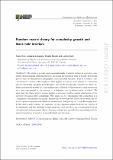Random matrix theory for complexity growth and black hole interiors
Author(s)
Kar, Arjun; Lamprou, Lampros; Rozali, Moshe; Sully, James
Download13130_2022_Article_17508.pdf (1.374Mb)
Publisher with Creative Commons License
Publisher with Creative Commons License
Creative Commons Attribution
Terms of use
Metadata
Show full item recordAbstract
Abstract
We study a precise and computationally tractable notion of operator complexity in holographic quantum theories, including the ensemble dual of Jackiw-Teitelboim gravity and two-dimensional holographic conformal field theories. This is a refined, “microcanonical” version of K-complexity that applies to theories with infinite or continuous spectra (including quantum field theories), and in the holographic theories we study exhibits exponential growth for a scrambling time, followed by linear growth until saturation at a time exponential in the entropy — a behavior that is characteristic of chaos. We show that the linear growth regime implies a universal random matrix description of the operator dynamics after scrambling. Our main tool for establishing this connection is a “complexity renormalization group” framework we develop that allows us to study the effective operator dynamics for different timescales by “integrating out” large K-complexities. In the dual gravity setting, we comment on the empirical match between our version of K-complexity and the maximal volume proposal, and speculate on a connection between the universal random matrix theory dynamics of operator growth after scrambling and the spatial translation symmetry of smooth black hole interiors.
Date issued
2022-01-05Department
Massachusetts Institute of Technology. Center for Theoretical PhysicsPublisher
Springer Berlin Heidelberg
Citation
Journal of High Energy Physics. 2022 Jan 05;2022(1):16
Version: Final published version